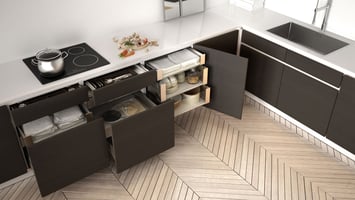Cabinet making is as much about the beauty of the finished product as it is about its durability....
How to Price Your Cabinetry Projects

Accurate pricing is essential for the success of any cabinetmaking business. Striking the right balance between craftsmanship, materials, and profitability ensures that your business thrives while maintaining a reputation for quality work. This article will discuss key factors to consider when pricing cabinetry projects and tips for finding the perfect balance.
- Material Costs:
Material costs play a significant role in determining the overall price of a cabinetry project. Consider the following when estimating material expenses:
- Type of wood or surface material (veneer, laminate, solid wood, etc.)
- Hardware (hinges, drawer slides, knobs, etc.)
- Finish materials (stains, paints, sealers, etc.)
Be sure to account for any waste, as well as potential price fluctuations due to market changes or seasonal availability.
- Labor Costs:
Labor costs encompass both the time spent on design and the actual construction of the cabinetry. Consider the following factors when calculating labor costs:
- Design hours, including client consultations and revisions
- Construction time, including cutting, assembling, and finishing the cabinets
- Installation, if applicable
Don't forget to account for the skill and experience level of your team when determining hourly rates.
- Overhead Costs:
Overhead costs include rent, utilities, insurance, and other expenses associated with running your business. To accurately price your cabinetry projects, you must factor in these costs. Allocate a portion of your overhead costs to each project based on the project's duration and size.
- Profit Margin:
Your profit margin is essential for the growth and sustainability of your business. When pricing your cabinetry projects, ensure that you establish a fair profit margin that reflects the quality of your work and the level of service you provide.
Tips for Balancing Craftsmanship, Materials, and Profitability:
- Be transparent with clients: Clearly explain the costs associated with their cabinetry project, emphasizing the quality of materials and craftsmanship you provide.
- Offer options: Provide clients with different material and design choices at various price points, allowing them to make informed decisions based on their budget.
- Optimize your workflow: Streamline your design, construction, and installation processes to minimize labor costs without compromising quality.
- Regularly review your pricing: Reevaluate your pricing structure periodically to ensure that it remains competitive and accurately reflects your business's costs and value.
Conclusion:
Accurately pricing your cabinetry projects is essential for maintaining profitability and a reputation for quality work. By considering material, labor, overhead costs, and profit margin, cabinetmakers can find the perfect balance that ensures the success of their business.



